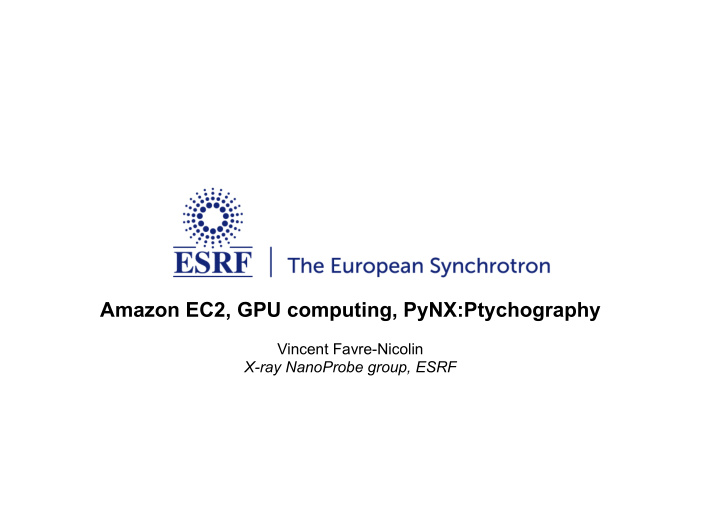



Amazon EC2, GPU computing, PyNX:Ptychography Vincent Favre-Nicolin X-ray NanoProbe group, ESRF 1 l 66TH MEETING OF THE ESRF l 30-31 May 2014 l Author 26/07/2013
AMAZON GPU COMPUTING Gpu Accelerated computing instances: • (old) G2: nVidia GRID K520 • P2: nVidia K80 (early 2015) (12GB, 4 Tflops theor.) • P2.xlarge: 1 K80, 61 GB memory • P2.8xlarge: 4 K80, 488 GB memory • P2.16xlarge: 8 K80, 732 GB memory • Performance ? • Usability for data analysis ? Page 2 l PANDAAS working group l 12 December 2016 l Vincent FAVRE-NICOLIN 26/07/2013
PyNX: PTYCHOGRAPHY • On-going effort to provide tools for on/offline analysis for Coherent Imaging techniques • Focused on using GPU/OpenCL for faster computing • Used at id01, id13@ESRF, running on dedicated GPU machines (GPU: Titan X) • 2D Ptychography: • Coherent images taken at different positions on a sample • 100 to 1000 of images-moderatly fast data acquisition (1-100Hz) • Dataset can be exported in CXI format (http://cxidb.org/cxi.html) Page 3 l PANDAAS working group l 12 December 2016 l Vincent FAVRE-NICOLIN 26/07/2013
IPYTHON NOTEBOOK: PyNX.PTYCHO ssh -CX -L:8888:localhost:8888 admin@ec2.****.compute.amazonaws.com � ipython3 notebook --pylab=inline • Quick test : launch ipython notebook • Machine: • debian 8 official • Nvidia drivers, OpenCL, clFFT • Scientific python packages + PyNX • Data (already transferred 87Mb) • Go to browser • Choose kernel for data analysis • Tweak parameters • Run analysis • Change parameters as needed and restart … LIVE DEMO Page 4 l PANDAAS working group l 12 December 2016 l Vincent FAVRE-NICOLIN 26/07/2013
IPYTHON NOTEBOOK: PyNX.PTYCHO • GPU Analysis works (including using multi-GPU) • Some latency in initializing the GPUs ? (up to 20s) • No issues otherwise • Compared speed: GPU K80 (Amazon) Titan X (ESRF) Read data (cxi) 58 Mpixel/s 86 Mpixel/s 2D FFT (400x400, 32 stack) 116 Gflop/s 282 Gflop/s dt/cycle (AP, 1025 frames) 0.544s 0.223s • Notebook can easily be configured to automatically be available when starting the machine Page 5 l PANDAAS working group l 12 December 2016 l Vincent FAVRE-NICOLIN 26/07/2013
AMAZON GPU COMPUTING: CONCLUSION Pros: • On-demand GPU availability • Large computing power available • Best for offline/post-experiment data analysis • Extremely easy to provide AMIs with software for users when they need it offline • Avoid conflicts between different software by providing several AMIs • Notebook analysis is very simple to use, flexible • Remote GUI processing possible (ssh –X,..) • Also great for tutorials (e.g. HERCULES) • On-demand cost ($0.2-1/hour/GPU) Cons: • GPUs a bit outdated (no Maxwell, no Pascal) -> performance /2 compared to Maxwell Titan X • Notebook interface: • great only for linear data analysis process ? • No point-and-click interactivity • Not for ‘big’ data experiments (>>1Tb compressed) ? TODO: • Simplified user auth / data access Page 6 l PANDAAS working group l 12 December 2016 l Vincent FAVRE-NICOLIN 26/07/2013
Recommend
More recommend